14 Best Dog Foods for Akitas: Our 2025 In-Depth Feeding Guide
Quick Guide
- What is the Best Dog Food for Akitas:
- Understanding an Akita’s Diet Requirements
- Special Dietary Considerations for Akitas
- Akita Puppy and Adult Feeding Chart
- The Best Dog Food for Akitas: Our Top 15 Picks for 2025
- 3 more Top Rated (5 Star) Akita Adult Foods:
- 3 More Top Rated (5 Star) Akita Puppy Foods:
- 2 More Picks for Senior Akita Foods
- Our FAQ and Akita Feeding Guide
- A Final Word
The Akita is more than just a Japanese breed – he is a national monument in his home country.
Akitas are large, spitz-type dogs originally developed to hunt large game but today they are typically used for guarding or police work in addition to being a family pet. These dogs are classified as a large or giant breed, standing 24 to 28 inches tall and weighing 65 to 115 pounds at maturity.
The Akita is a bold and independent breed, devoted to his family but aloof around strangers. Though these dogs are very intelligent, they can be a challenge to train and can be fairly territorial. They also have a high prey drive and may be aggressive toward unfamiliar dogs. With family, however, they are playful and affectionate and will stop at nothing to defend the ones they love.
Because the Akita is such as large and powerful breed, he requires a high-quality diet. The best Akita diet is rich in protein with moderate fat content and supplemented with joint-supporting nutrients.
Keep reading to learn more about your Akita’s dietary requirements and to see our top 15 picks for the 2025 best dog food for Akitas.
What is the Best Dog Food for Akitas:
Understanding an Akita’s Diet Requirements
All dogs require a balance of protein, fat, and carbohydrates in their diet. Protein is the most important nutrient because it helps your dog build and maintain strong muscles. Amino acids are the building blocks of protein, and there are 22 of them – 10 are called essential amino acids because they must come from your dog’s diet. Animal-based proteins like poultry, meat, and fish are the best proteins for dogs like your Akita because they contain all 10 essential amino acids.
Healthy fats provide your dog with a concentrated source of energy as well as essential fatty acids for skin and coat support. These too should come from animal sources as much as possible, because your Akita’s body has a limited ability to metabolize certain plant oils. Your dog has no specific needs for carbohydrates, but grains and vegetables provide dietary fiber and essential nutrients. Look for a recipe that contains between 3% and 5% dietary fiber.
- Puppy Akitas – As a puppy, a minimum of 22% of your Akita’s diet should come from quality animal proteins, and at least 8% should come from healthy fats. While he is growing, your puppy will need a more protein- and calorie-rich diet than he will as an adult to support his development. However, you should be careful of feeding him too many calories, or he might grow too fast. Controlling your puppy’s growth and limiting his intake of calcium and phosphorus will reduce his risk for skeletal problems later.
- Adult Akitas – Though your Akita may not reach his full size until 2 or 3 years of age, you may want to switch him to an adult recipe after 12 months to make sure he doesn’t grow too fast. Your adult Akita needs a minimum of 18% crude protein in his diet and a minimum of 5% crude fat. Remember, more protein is usually better but control the fat content to keep the caloric density moderate.
- Senior Akitas – As your Akita ages, his metabolism will slow down, and you may need to adjust his diet to prevent weight gain. Consider switching to a senior recipe (large-breed specific, if possible) or to a weight management recipe. Just make sure that your Akita still gets enough protein to maintain lean muscle mass but lower his fat intake to control calories. You may also want to supplement his diet with glucosamine and chondroitin to keep his joints healthy in old age.
If you remember nothing else about your Akita’s dietary requirements, remember that you should be feeding him a large- or giant-breed dog food. These recipes are designed to support lean muscle mass and to prevent obesity so, as long as you follow the feeding instructions, your Akita should do fine.
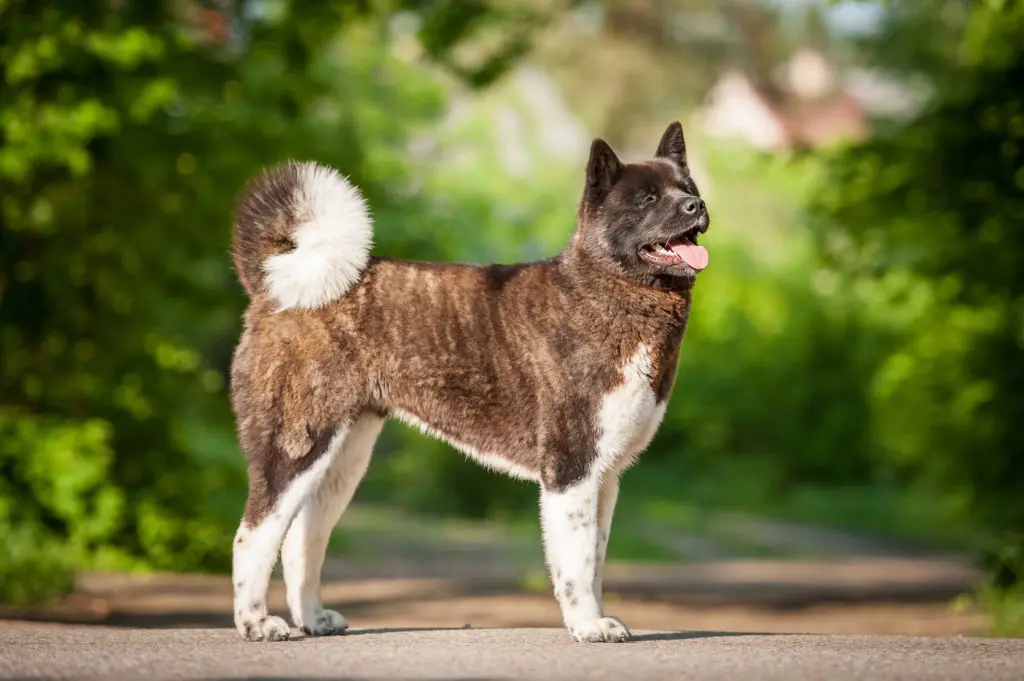
Special Dietary Considerations for Akitas
The Akita is an ancient breed, descendant from one of the oldest breeds native to Japan, the Matagi Dog. As an ancient breed, the Akita is generally very healthy dog, but all dogs have the potential to develop certain health problems.
Here is a quick list of the health problems to which the Akita may be prone:
- Addison’s Disease
- Cruciate Ligament Injury
- Entropion
- Gastric Dilation
- Glaucoma
- Hip and Elbow Dysplasia
- Progressive Retinal Atrophy
- Sebaceous Adenitis
- Uveodermatologic Syndrome
- Von Willebrand’s Disease
Most of the conditions to which the Akita may be prone are musculoskeletal issues, eye problems, and skin conditions. Some of these health problems are directly impacted by your dog’s diet while others are less of a concern. Generally speaking, feeding your Akita a product made from wholesome and high-quality ingredients is important to maintain healthy bodily function.
The three conditions you really need to focus on in terms of your Akita’s diet are gastric dilation, hip and elbow dysplasia, and sebaceous adenitis. Gastric dilation is a life-threatening condition in which the stomach dilates, either due to food or gas, which creates pressure and blocks the flow of blood to the heart. This is most likely to happen if your Akita eats too much at once, eating too quickly, exercising too soon after a meal, and swallowing air while eating. There are no specific dietary factors involved, but you should be mindful of how much food you give your dog at any meal.
Hip and elbow dysplasia are common musculoskeletal issues seen in larger breeds like the Akita, and they are typically characterized by malformation of the hip or elbow joint. Maintaining a healthy body weight is essential for managing this condition, so avoid dog foods that are too high in calories and fat. You should also look for a product that contains joint-supporting nutrients like glucosamine and chondroitin. When your Akita is a puppy, controlling his growth and his intake of calcium and phosphorus will reduce his risk for developing skeletal issues like these in adulthood.
Sebaceous adenitis is an inflammatory skin disease that can lead to symptoms such as hair loss, matting, brittle or coarse fur, intense itching, bacterial infections, and small lesions on the skin. The exact cause for this condition is unknown, but there are treatments available. In addition to antibiotic and antibacterial products, making sure your Akita gets the right balance of essential fatty acids in his diet may also help improve his skin and coat health.
Akita Puppy and Adult Feeding Chart
Because the Akita is a giant breed, he may take up to 3 years to reach his full adult size. Throughout the course of his life, you need to provide him with plenty of lean protein to support his lean muscle mass with moderate fat for energy and carbohydrates for fiber.
In terms of how much to feed your Akita, you’ll want to feed your Akita puppy three meals per day. Start by selecting a high-quality large- or giant-breed puppy recipe and refer to the feeding instructions to determine how much food your puppy needs per day. From there, divide it into three meals and space them out evenly across the day. After the first year, or when your Akita reaches about 75% of his expected adult size, you can switch him to an adult diet.
Feed your adult Akita a large- or giant-breed adult recipe. These products are rich in protein to help your dog maintain lean muscle mass with moderate fat content for energy and skin/coat support. Again, refer to the feeding recommendations on the package to determine how much to feed your Akita per day then divide it into two meals. When your Akita becomes a senior dog, his metabolism will slow so you may want to feed him a little less at each meal or switch to a weight management or senior dog food.
The Best Dog Food for Akitas: Our Top 15 Picks for 2025
Now that you have a better understanding of a healthy Akita diet, you’re ready to start shopping around. Remember, the best dog food for Akitas will be rich in animal protein with moderate fat content and plenty of digestive and joint-supporting supplements. Here are our top 15 best Akita dog food picks:
| Our 2025 Picks: Best Food for Akitas | |||
| Rank | Dog Food | Price | Rating |
|
Overall |
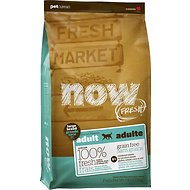 | $3.15/lb |
A+
|
|
Most Affordable |
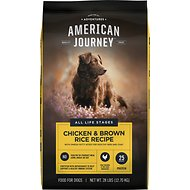 | $1.12/lb |
A+
|
|
Most Popular |
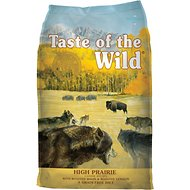 | $1.55/lb |
A+
|
|
Human Grade |
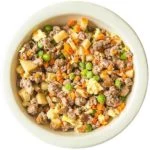 | Varies |
A+
|
|
Allergies |
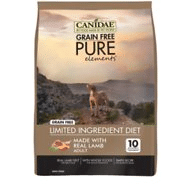 | $2.57/lb |
A
|
Now Fresh Large Breed Adult Dog Dry Food

Overall Best Food for Akitas: For a high-quality Akita diet that your dog is sure to love, we recommend Now Fresh Large Breed Adult Dog Dry Food. This recipe is made with three premium proteins, 100% fresh turkey, salmon, and duck to deliver 27% crude protein. With grain-free carbohydrates like potatoes and peas, this recipe is highly digestible and formulated specifically for large-breed dogs. It contains a blend of omega fatty acids for healthy skin and coat as well as supplemental glucosamine and chondroitin for joint support. It also contains chelated minerals to ensure optimal nutrient absorption and dried fermentation products to provide probiotic digestive support.
- Pros: Made with 100% fresh meats, digestible grain-free carbohydrates, fresh fruits, and vegetables, blend of omega fatty acids, chelated minerals, probiotics, glucosamine and chondroitin
- Cons: Very expensive, main source of fat is plant-based
American Journey Chicken & Brown Rice Adult Dry Food

Most Affordable Food: If you don’t have a big budget to work with, this American Journey Chicken & Brown Rice Adult Dry Dog Food is affordable and offers decent quality. It may not be large-breed specific, but it contains plenty of protein with moderate fat and calorie content. It features both deboned chicken and chicken meal as the top two ingredients with digestible carbohydrates like brown rice and peas. Nutrient-rich chicken fat provides plenty of essential fatty acids for healthy skin and coat while fresh fruits and vegetables help to ensure nutritional balance.
- Pros: Affordable and high-quality, rich in animal protein, moderate fat and calorie content, digestible carbohydrates, healthy animal fats, chelated minerals, fresh fruits and vegetables
- Cons: Not large-breed specific, not a grain-free recipe, contains plant protein concentrates
Taste of the Wild High Prairie Dry Dog Food

Most Popular Food: Easily one of the most popular dog food brands on the market, Taste of the Wild offers grain-free diets for dogs that are made with premium roasted meats and other natural ingredients. This Taste of the Wild High Prairie Dry Dog Food is made with roasted bison and venison as well as other premium proteins such as lamb, chicken, and beef. It features grain-free, digestible carbohydrates like sweet potatoes and peas with canola oil and ocean fish meal to provide a balance of omega fatty acids. The only problem is that it is not large-breed specific, so follow the feeding instructions carefully.
- Pros: Made with premium roasted meats, contains 32% protein, grain-free digestible carbohydrates, dried fermentation products for probiotic support, chelated minerals
- Cons: Not large-breed specific, contains plant protein concentrates, main source of fat is plant-based
NomNom Fresh Dog Food

Super Premium Food: If you’re in the market for the best dog food money can buy, NomNomNow deserves to be on the list. This company delivers fresh dog food right to your door, so you can give your Akita the best diet possible. You simply fill out a profile online then choose a recipe. From there, NomNomNow develops a custom diet for your dog based on his calorie requirements and delivers the food fresh to your door each and every week. The quality of this dog food is hard to beat, but it does come with a hefty price tag. You can also rest easy knowing that there are no artificial ingredients or preservatives.
- Pros: Delivered fresh to your door, catered to your dog’s calorie needs, made with high-quality ingredients, never frozen or artificially preserved
- Cons: Very expensive, limited number of recipes to choose from
Canidae PURE Elements with Lamb Limited Ingredient Diet

Best Food for Akitas with Allergies: If your Akita suffers from food allergies, a limited ingredient diet may be the way to go. These products are made with a limited number of main ingredients to reduce the risk for triggering food allergies and sensitivities. This Canidae PURE Elements with Lamb Limited Ingredient Diet is an excellent example because it contains just 10 main ingredients, the first being fresh lamb.
In addition to containing several high-quality sources of animal protein, this recipe is grain-free and highly digestible. It features sweet potatoes and chickpeas as the carbohydrates with chicken fat as a nutritious source of essential fatty acids. In addition to natural flavors, this recipe also contains vitamin supplements, chelated minerals, and probiotics.
Pros: Rich in high-quality animal protein, grain-free digestible carbohydrates, only 10 main ingredients, rich in healthy fats, chelated minerals, probiotic supplements
Cons: Some dogs are sensitive to chicken ingredients, somewhat expensive, not large-breed specific
Nutro Limited Ingredient Grain-Free Large Breed Recipe
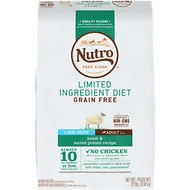
Best Food for Akitas with Sensitive Stomachs: If your Akita has a sensitive stomach, the quality of his diet is extremely important. It should be made from wholesome natural ingredients with no fillers or artificial additives. It may also be a good idea to go grain-free, in case that’s what’s causing your dog’s issues. This Nutro Limited Ingredient Diet Grain-Free Large Breed Recipe is a good example.
Made with all-natural, non-GMO ingredients, this formula features real lamb as the main ingredient with grain-free carbohydrates like sweet potatoes and chickpeas. Nutro follows a “Feed Clean Philosophy,” so you can rest assured of the quality of this dog food. It also helps that it is free from corn, wheat, and soy, and that it is supplemented with chelated minerals for maximum nutrient absorption.
- Pros: Limited ingredient recipe, grain-free, single source of animal protein (lamb), no fillers or artificial additives, chelated minerals, formulated for large breeds
- Cons: Contains some plant protein concentrates, no probiotic supplements
3 more Top Rated (5 Star) Akita Adult Foods:
| Life Stage | Dog Food | Price | Rating |
|
Adult |
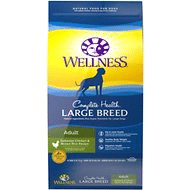 | $1.88/lb |
A
|
|
Adult |
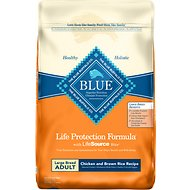 | $1.51/lb |
A
|
|
Adult |
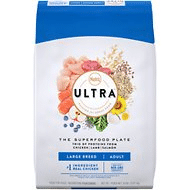 | $1.83/lb |
A
|
Wellness Complete Health Large Breed Adult Recipe

Featuring deboned chicken and brown rice, this large breed adult dog food supports your Akita’s lean muscle mass while providing for his energy needs. It is made with all-natural ingredients, no by-products or fillers, and has probiotics for digestive health. IT also contains guaranteed levels of glucosamine and chondroitin for lifelong joint support.
Blue Buffalo Life Protection Formula Large Breed Adult

Formulated specifically for large breeds, this recipe contains L-carnitine for strong muscles, calcium for bone development, and glucosamine and chondroitin for joint support. It features deboned chicken as the main ingredient with digestible whole grains like brown rice for carbohydrate support. This recipe is designed to keep your dog’s immune system strong and his skin healthy while also supporting regular digestion. Plus, it contains Blue Buffalo LIfeSource Bits to provide vitamins, minerals, and antioxidants.
Nutro Ultra Large Breed Adult Dry Food

This large-breed adult recipe features real chicken as the main ingredient with digestible whole grains like brown rice and oatmeal for carbohydrates. It also contains a superfood blend to provide natural sources for key nutrients, including antioxidants. It is completely free from GMO ingredients and artificial additives, but contains beneficial supplements like chelated minerals to ensure maximum nutrient absorption. Plus, it is rich in protein and fiber but moderate in fat and calorie content.
3 More Top Rated (5 Star) Akita Puppy Foods:
| Life Stage | Dog Food | Price | Rating |
|
Puppy |
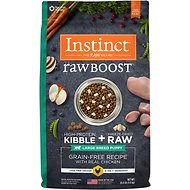 Nature’s Variety Instinct Raw Boost Large-Breed Puppy Recipe | $3.32/lb |
A
|
|
Puppy |
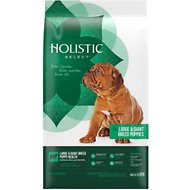 | $1.89/lb |
A
|
|
Puppy |
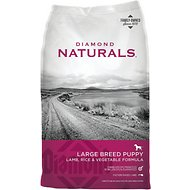 | $5.58/lb |
B+
|
Nature’s Variety Instinct Raw Boost Large-Breed Puppy Recipe

Easily one of the top puppy foods on the market, this recipe features high-protein kibble mixed with freeze-dried raw pieces. Not only does this combination ensure maximum protein levels, but it also makes this recipe highly flavorful for your puppy to enjoy. It features real cage-free chicken as the first ingredient with digestible grain-free carbohydrates like chickpeas and peas. You’ll also be glad to know that it contains chelated minerals and probiotic supplements.
Holistic Select Large & Giant Breed Puppy Recipe

Designed specifically for giant breed puppies, this recipe features both lamb meal and chicken meal to meet your Akita puppy’s high needs for protein. It is made with digestible whole grains like oatmeal and brown rice which nutrient-rich chicken fat for essential fatty acids. This recipe is free from by-products and artificial additives but supplemented with chelated minerals and probiotics. It also contains fresh fruits and vegetables for natural sources of key vitamins and minerals.
Diamond Naturals Large Breed Puppy Formula

An affordable option in large-breed puppy food, this recipe features lamb, rice, and vegetables as the main ingredients. This formula is rich in healthy animal fats to support your Akita’s skin and coat as well as dried fermentation products to support his digestion. It also contains fresh fruits and vegetables which provide anti-aging antioxidants and act as natural sources for key nutrients. Plus, it is free from artificial additives and low-quality fillers.
2 More Picks for Senior Akita Foods
| Life Stage | Dog Food | Price | Rating |
|
Senior |
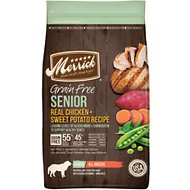 | $1.06/lb |
A
|
|
Senior |
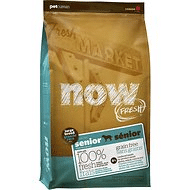 Now Fresh Grain-Free Large Breed Senior Weight Management Recipe | $2.94/lb |
B+
|
Merrick Grain-Free Senior Chicken & Sweet Potato Recipe

As your Akita gets older, he may be more prone to food allergies and sensitive stomach, so this grain-free recipe is a great choice. Featuring protein-rich chicken and grain-free sweet potatoes, this formula is highly digestible. It contains 55% protein and healthy fat ingredients with 45% fresh produce and beneficial supplements. It also contains leading levels of glucosamine and chondroitin for healthy joints.
Now Fresh Grain-Free Large Breed Senior Weight Management Recipe

Designed specifically to meet the changing nutritional needs of large-breed seniors, this recipe features deboned turkey, salmon, and duck as well as digestible grain-free carbohydrates like potatoes and peas. It is rich in animal fats to ensure healthy skin and coat and contains fresh fruits and vegetables for antioxidants and natural sources of key nutrients. This formula also contains New Zealand green mussels for extra glucosamine and chondroitin as well as chelated minerals and probiotics.
Our FAQ and Akita Feeding Guide
When it comes to feeding your Akita, there are a few things you should know. First, Akitas have a tendency to become food aggressive so you may need to do some training while your Akita is a puppy. Try feeding him part of his meal by hand and get him used to being touched while he is eating. If your Akita has a tendency to eat too quickly, try using a slow-feed bowl that forces him to slow down.
Choosing the best Akita diet is only half the battle. Once you buy the food, you need to keep it fresh. The best thing to do is store the bag in a cool, dry place – don’t empty it into a plastic container because the bag has already been treated to protect the food and preserve its freshness. If you want to use a separate container, simply put the bag in the container.
And now, here are the answers to some of the most commonly asked questions about feeding an Akita:
How much food should I feed my Akita?
The amount of food you give your Akita will vary according to his age and weight – it also depends on the type of Akita dog food you choose. Generally speaking, however, you’ll be feeding your Akita somewhere in the range of 5 to 6 cups of food per day. Keep in mind that the calorie content will vary from one product to another, so refer to the feeding recommendations on the package to see exactly how much you should feed your Akita each day.
How many times a day should I feed my Akita?
You’ve already learned about the risk for gastric dilation, and the best way to prevent it is to avoid giving your Akita too much food at once. It is generally recommended that you feed adult dogs two meals a day, spacing them out in the morning and in the evening. If your Akita is particularly active, you may want to give him a midday snack to keep his energy up. Puppies can be fed three small meals per day, just make sure you’re not feeding your Akita so much that he grows at an unhealthy weight.
What kind of food do Akitas eat?
When it comes to choosing a type of food to feed your Akita, price is a significant concern. While you should never shop for dog food by price alone, you should be aware of the fact that your Akita may grow to be over 100 pounds, so he’ll be eating a lot of food. Raw or fresh food is always an excellent choice if you can afford it, but the cost to feed an Akita a fresh food diet might be prohibitive. The most cost-effective option is probably a high-quality dry food. If you want to supplement your Akita’s dry food with some wet food or a food topper, it could help keep his skin and coat healthy.
What vegetables are good in an Akita food?
Though you may not think of vegetables as an ingredient in dog food, they can actually be very beneficial. In addition to providing a boost of dietary fiber, fresh vegetables also act as natural sources for key nutrients in dog food. Here are some of the best vegetables for dogs:
- Asparagus
- Broccoli
- Brussels sprouts
- Carrots
- Cauliflower
- Cucumber
- Green beans
- Peas
- Pumpkin
- Spinach
- Sweet potato
- Zucchini
When it comes to high-protein vegetables like peas and potatoes, be mindful of their placement on the ingredients list – if they are too close to the beginning, they could be a significant contribution to the recipe’s total protein content.
Do Akitas need grain-free dog food?
There is a great deal of controversy surrounding the use of grain-free dog food in general. Whether or not your Akita needs a grain-free diet depends primarily on his ability to digest grains. Whole grains like brown rice and oatmeal are digestible for most dogs, but your Akita may be sensitive to or allergic to grains. If he suffers from frequent ear infections, skin problems, or digestive upset, it may be a sign of a food allergy or sensitivity, and grains could be the culprit. Aside from a medical need to follow a grain-free diet, however, your Akita should do well on either a regular or grain-free diet.
A Final Word
Your Akita deserves the best dog food you can consistently afford, so take the time to make a smart choice! His diet should be rich in animal protein with moderate amounts of healthy animal fats and digestible carbohydrates. He will also benefit from probiotics and fresh fruits and vegetables to provide natural sources for key nutrients.
Choosing the best dog food for an Akita doesn’t have to be hard. Take what you’ve learned here and put it to use or go with one of our top 15 recommendations! Good luck!










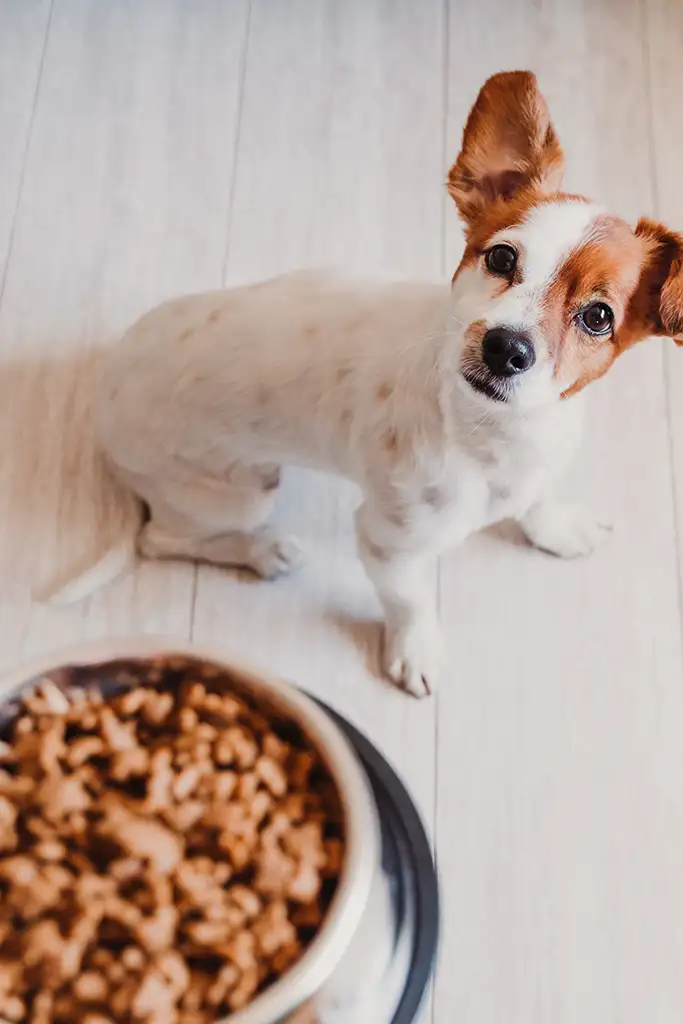
Hi
My akita is 10 months old and 20kg. Is that normal weight or not?
Thank You
Is your akita male or female? My pup is almost six months, and he’s 32kg… which sounds very heavy by comparison. But he’s already quite tall and does not look chubby, he looks very proportioned.
I have two Akitias about 2yrs old at different weights. One it stocky at 42kg and the other is taller more slender but not skinny at 32kg both are health females. Your pup may be more slinder but he or she will get big.